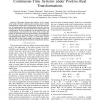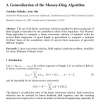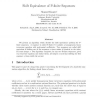73 search results - page 1 / 15 » Positivity of second order linear recurrent sequences |
83
Voted
DAM
2006
15 years 20 days ago
2006
We give an elementary proof for the Positivity Problem for second order recurrent sequences: it is decidable whether or not a recurrent sequence defined by un = aun-1 + bun-2 has ...
105
Voted
BMCBI
2010
15 years 23 days ago
2010
Background: Large datasets of protein interactions provide a rich resource for the discovery of Short Linear Motifs (SLiMs) that recur in unrelated proteins. However, existing met...
76
Voted
ISCAS
2007
IEEE
2007
IEEE
Analysis of Second-Order Modes of Linear Continuous-Time Systems under Positive-Real Transformations
15 years 7 months ago
Abstract— This paper discusses the behavior of the secondorder modes of linear continuous-time systems under variable transformations with positive-real functions. We first disc...
99
Voted
AAECC
1998
Springer
15 years 11 days ago
1998
Springer
The set of all linear recurrence relations satisfied by given sequences of finite length is described by the annihilator ideal of the sequences. The MasseyDing algorithm to compu...
102
Voted
COMBINATORICS
2006
15 years 21 days ago
2006
We present an algorithm which decides the shift equivalence problem for Pfinite sequences. A sequence is called P-finite if it satisfies a homogeneous linear recurrence equation w...



